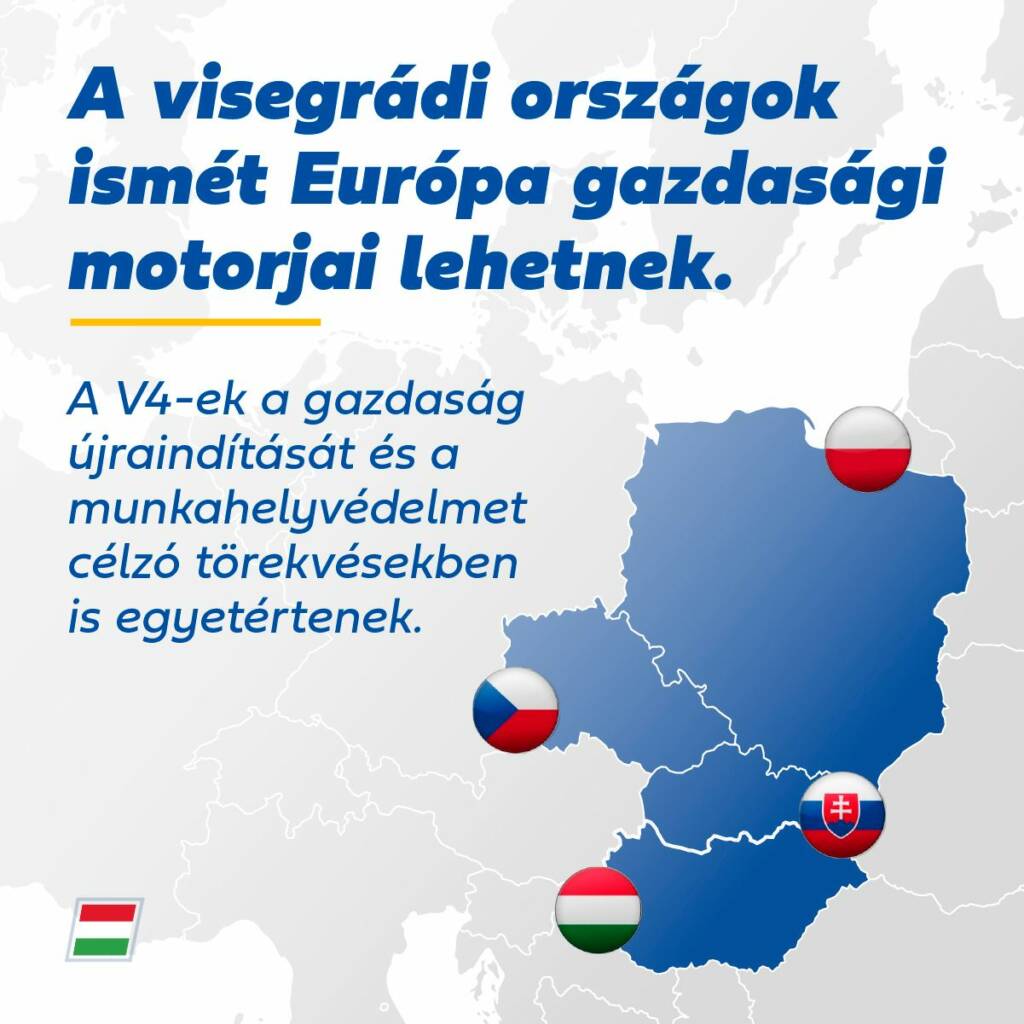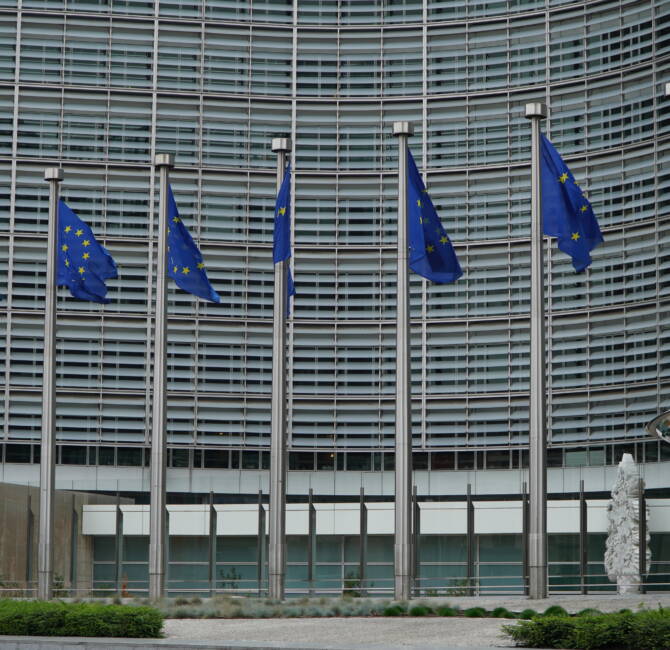Hungary – EU member states have until 30 April to submit a plan for the usage of the 672.5 billion Euros that the Commission is going to levy from the financial markets during the next four years. This levy, entitled “Recovery and Resilience Facility” (hereafter termed “RRF”), is the principal part of the “Next Generation EU” plan, which has been conceived to offer a way out of the current crisis by encouraging reforms and investments.
Contrary to Poland, which hasn’t yet submitted a detailed plan due to having to deal with what appears to be dealing with a governmental crisis, the Hungarian government published a 400-page document on 13 April, detailing how it intends to spend its share of the levy, 16 billion Euros (5.800 billion forints), which it should obtain until 2026 in the forms of grants and loans when the RRF comes into effect on 19 February 2021.
Following a meeting between Prime Minister Viktor Orbán and EU Commission President Ursula von der Leyen in Brussels on Friday 23 April, it appeared that Hungary was only interested by the RRF funds on offer via grants, which represents half of the overall package, before then proceeding to producing their detailed document before the 30 April dead-line. However, it is important to analyse the general approach of the RRF and query what it could mean.
“Green and Digital”
Adding to the 1074.3 billion Euros allotted to the member states during the 2021-2028 period with the multiannual financial framework, the RRF is supposed to assist in repairing the economic and social damage caused by the COVID-19 pandemic and, in the long-term, to guarantee sustainable and inclusive recovery, encouraging the digital and ecological transition. These aims are in line with the Commission’s European Semester’s priorities, the recommendations adopted by the Council, the European Green Deal and the Annual Sustainable Growth Strategy 2021.
National plans, proposed by the member states, must fit into this framework which can be summarised as environmental sustainability, productivity, justice and macroeconomic stability.
Broadly speaking, there is no doubt that these aims fit in nicely with those elaborated by the Davos World Economic Form and the concepts of the Fourth Industrial Revolution.
The similarities between the documents published by the EU Commission and the World Economic Forum are quite glaring. Words such as “green”, “climate”, “resilience”, “inclusive” and “digital” are overly used. One only needs to reads the on-line publications and speeches of both these institutes to realise how perfectly aligned the conceptual proximity between Brussels and Davos is. The controversies and delusions that might be provoked by mentioning these two words together has no affect on our work methodology, which consists of simply reading and inspecting the publications of those that work within these institutions concerning the changes brought about by the “COVID-19 pandemic”. Did we take these publications too seriously? Did their authors take themselves too seriously? Only time will tell.
In any event, national plans will have to earmark at least 37% of the RRF to meet environmental targets and at least 20%to digital targets. This is something that is unprecedented in the history of recovery plans or stimulus packages.
In this case, the spirit of the plan goes beyond a simple stimulus package since it is more or less publicly declaring the start of a new era, which the EU Commission and its civil servants call “Green and Digital”.
The problematic nature of national plans
Hungary already presented its plan, which include the following components:
- Demography and Education
- Modernisation of higher education
- Rural development
- Water resource management
- Sustainable transportation
- Green energy transition
- Transition to a circular economy
- Digital reform to benefit competitivity
- Health
It is clear when regarding the plan that the Hungarian government has not only devoted whole chapters to environmental or digital considerations, but also other projects in the educational and health sectors by adapting them to the declared environmental and digital criteria. It is difficult to imagine how the EU member states could do anything else when 57% of the grants and loans allotted must be to meet sustainable and digital objectives. Inevitably, this will lead to “bending the truth” in order to get projects to comply with the published criteria. However, the allocating of these funds is conditioned under an obligation of performance, meaning that a payment will only be given upon proof that it meets the criteria, with the Commission providing two payments per year until the end of 2026.
This system of performance requirements and multiple payments may force member states to undertake these projects in haste whilst “hiding” their true sustainable and digital vocation. The least one can say is that this is quite a flawed approach by the Commission since their intention is to craft a new generation and era into existence where the sustainability and resilience are the hallmarks.
On the contrary, the Recovery and Resilience Facility levy might well open the flood-gates to systematic short-termism.
From our point of view, these technical and specific aspects are more problematic than the endless debate on the rule of law, which the EU Commission didn’t fail to mention when talking to the Hungarian government about benefiting from the RRF. Unfortunately, during these negotiations between Budapest and Brussels, the rule of law question has often been for political posturing, distract public opinion and, of course, using double standards. Indeed, Hungary had to sacrifice its own Lex-CEU in order to just get a place at the negotiation table. From a strictly judicial point of view, it is unfortunate that both subjects have received very little attention.
Firstly, it seems suspicious that the EU Commission, whose democratic legitimacy is highly dubious, has as much prerogatives on what happens in the members states as those national leaders that have been elected via their respective electoral processes.
With regards to the RRF, can someone explain how a non-elected super-national structure can directly negotiate funds from the financial markets and then make the individual states responsible for reimbursing these creditors, be it directly or indirectly?
Of course, it is obvious that the member states all have questionable motives at times when it comes to establishing what constitutes “the rule of law” that they are supposed to respect but citizens can, if they wish, take control of their respective governments. By contrast, citizens have practically no way of taking control of the EU Commission. When it comes to the essential issue of public finances, the motives can be even more questionable for taxation with the consent of citizens is one of the pillars of parliamentary democracy.
Secondly, is it not somewhat problematic that within the halls of power of EU institutions, no interest is given to the consequences of restricted freedoms and the legitimacy of the “rule of law” when it comes to the measures that have been taken in “the fight against COVID-19” for more than a year now.
Are the changes that have taken place since March 2020 not big enough of an issue compared to the years of endless discussions between the EU, Hungary and Poland of what constitutes “the rule of law”?
The manner in which the EU and Hungary discuss this question of the rule of law is so vague that it would be welcoming to know exactly what the EU Commission and Council have against the Hungarian government.
Recommendations made to Hungary
The national plans also have to integrate the EU Council’s recommendations, which will have been validated by the Commission. In Hungary’s case, the recommendations essentially concentrate on the resilience of the Hungarian health system, unemployment benefits and the acceleration of opening up public markets to competition.
The “labour shortage in the health system” in Hungary mentioned by the Council’s recommendations is a consequence of the laws of the EU internal market, which has permitted Hungarian health workers to be siphoned off by member states in Western Europe. As long as those latter states continue with their austerity policies by employing Eastern European health professionals instead of their own citizens, then the situation of Hungary’s health service will not improve. This can also be extended to other Eastern European countries who also suffer from this issue. The probability of this happening in the intermediate term is close to zero.

But perhaps the Council and Commission aren’t that hypocritical since they have asked Hungary to train even more health professionals…In order to feed their appetite for such workers in Western Europe?
Furthermore, the reform of the Hungarian health system carried out last autumn (which put an end to financial kickbacks and raised doctors’ salaries, the latter of which the government hopes to finance with the RRF) encouraged health workers to “transfer” to the private health system. The EU institutions and the Hungarian opposition didn’t criticise this aspect of the reform even though, considering the financial situation of most Hungarian households would make it more or less impossible for them to afford private health care, it didn’t seem to be in step with the Council’s other recommendation of “improving the access to quality preventive and primary health care.”
Since 2010, the Hungarian government has always refused to change its policy concerning unemployment benefits, which are low and only last for three months in order to value labour and put it at the centre of the government’s political project. Are the Council and the Commission promoting the extension of these benefits, bearing in mind that these are supposed to be temporary and stop being paid upon the signing of an employment contract? That’s not so certain for, when one is looking for employment, there has to be some sort of work to find in the first place and it’s probable that the “non-resilient jobs” which the World Economic Forum talks about risk disappearing for the most part.
How can one not see this as the first step at the creation of a universal income?
For the moment, the Hungarian government is against such a creation whilst certain opposition parties are in favour of such a measure, which consists in paying people such an income with no time limit or emphasis to find employment. In other words, people would be paid to stay home.
With regards to opening up public markets to competition, the Council and the Commission are obviously making references to the fact that the Hungarian government does grant public infrastructure contracts to companies with close links to it. That the Council has the aim of opening up competition in terms of contractors does seem like a praiseworthy effort. However, this aim seems to be up against quite major obstacles which the current climate doesn’t make them easy to overcome.
The fact that the RRF grants and loans are conditioned upon a performance obligation and paid out in multiple instalments is an invitation to “dress-up” projects, in order to get them validated, and hasten their production, in order to collect funds quicker. Yet organising an open offer to tender is a slow process, to which one must also remember that apart from the first instalment (13% of the RRF, which for the most part will be used to finance 2020 national budgets), these payments will not be front-loaded but only upon providing guarantees that the performance obligations have been met.
It would be worthwhile reminding our readers certain facts that will undoubtedly blur the waters with regards to “free and fair competition”. The “COVID-19 crisis” has accelerated (maybe even finished) the suffocation of small businesses. One only needs to look to Germany or France to find evidence of this and we’ll let our readers imagine how things are for these businesses in smaller economies. In Hungary, entrepreneurship has been always been an activity that cannot be conducted without political support and explains, in part, why the entrepreneurial spirit is almost unknown and that those with capital are often used to consolidate political power. This is a reality that can be observed throughout the Hungarian political spectrum and whilst it can be something regretful, it is not the theoretical declarations about free and fair competition that will resolve this issue in any way. EU institutions and the Hungarian opposition lambast corruption but they never explain the origins of that corruption (which can’t be summarised simply by using the usual explanations regarding the venality of human nature or the will to keep power). The RRF system will only encourage existing practises which are incidentally condemned by both the Commission and Council.
These institutes also don’t seem to be much bothered by the risk that the RRF represents in terms of economic and social impacts.

The economic and social “logic” behind the RRF
The RRF operates on the condition of adopting the “Decision on Own Resources” by all EU member states. This system is constructed on the idea of creating future debts, which is more to the taste of the so-called “frugal countries” (Germany and the countries of Northern Europe) than the idea of sharing and paying back current debts together, which had an official complaint made against it at the Karlsruhe court last March.
The member states will reimburse the loans contracted for the RRF between 2028-2058. Bearing in mind the actual state of the European economies, it is cynical to believe that the countries will be able to honour these debts without having a general impoverishment of their populations. Even if Hungary refused to take these loans and took the grants instead, it will still be sucked into these new debts.
The EU Commission is relying on an economic upturn in order to raise new levies. However, the reality is that the Commission and European Central Bank are now committed to following a path that, since the 2008 economic crisis, has very little to do with stimulating economic growth and the “COVID-19 crisis” has only accelerated their head-long rush down this path.
The logic being put forward fails to make a difference between monetary creation and wealth creation. Indeed, contrary to the countries within China’s zone of influence, the countries of the European Union (with the exception of Sweden) and the United States have made the choice to monetise COVID-19, which means increasing monetary mass in order to finance the restrictive measures that have been enacted for over a year now.
There is nothing more heinous that to want to pass this increase in monetary mass off as automatic wealth creation. In other words, there is no immediate adjustment within the real economy when an adjustment within the financial economy is operated. This might even automatically lead to a weakening of national currencies of those countries that massively printed money in comparison with countries that decide not to go down that route. The citizens of the European Union would therefore suffer the consequences in terms of adverse effects on prices. To better understand the impact of these monetary and budgetary choices, we can recommend our readers to consult the work carried out by the Institut des Libertés a number of years ago.
Since the utterance of Mario Draghi’s “Whatever it takes” when he was still the head of the ECB, which has since been taken up by French President Macron and his “Quoiqu’il en coûte”, massive monetary injections (the so-called “bazooka”) seems to now be the rule and its benefits on the real economy are insignificant. It appears that everything is being done to keep the financial markets going, whether they correspond to the real economy or not.
We are now in a regime with administered prices, which are no longer affected by the market and that don’t correspond to any underlying value. The best example of this is without doubt the existence of negative interest rates, which simply indicates that credit risk and, de facto, entrepreneurship, has disappeared and thus, in fine, so has the creation of wealth.
By accepting negative interest rates, it means that the future is now more certain than the present which is quite consistent with the current fixation for sanitation, tracing and control. The European Green Deal puts down the foundations of a taxonomy of economic and social behaviours, a system of green social credit in which ideological criteria trumps the real creation of wealth. The universal income is the perfect example of a monetary creation free without any tangible quid pro quo.
Some reading this will see signs of a sovietisation of our European societies in full swing, with the probable result being that they will crash into a wall once reality catches up since financial systems underpinned by fake money have a bad habit of never lasting for very long.
“People pretend to work and we pretend to pay them.” Leonid Brezhnev
“Order without freedom eventually creates its own counterpoise.” Henry Kissinger
—
Translated from French by the Visegrád Post




